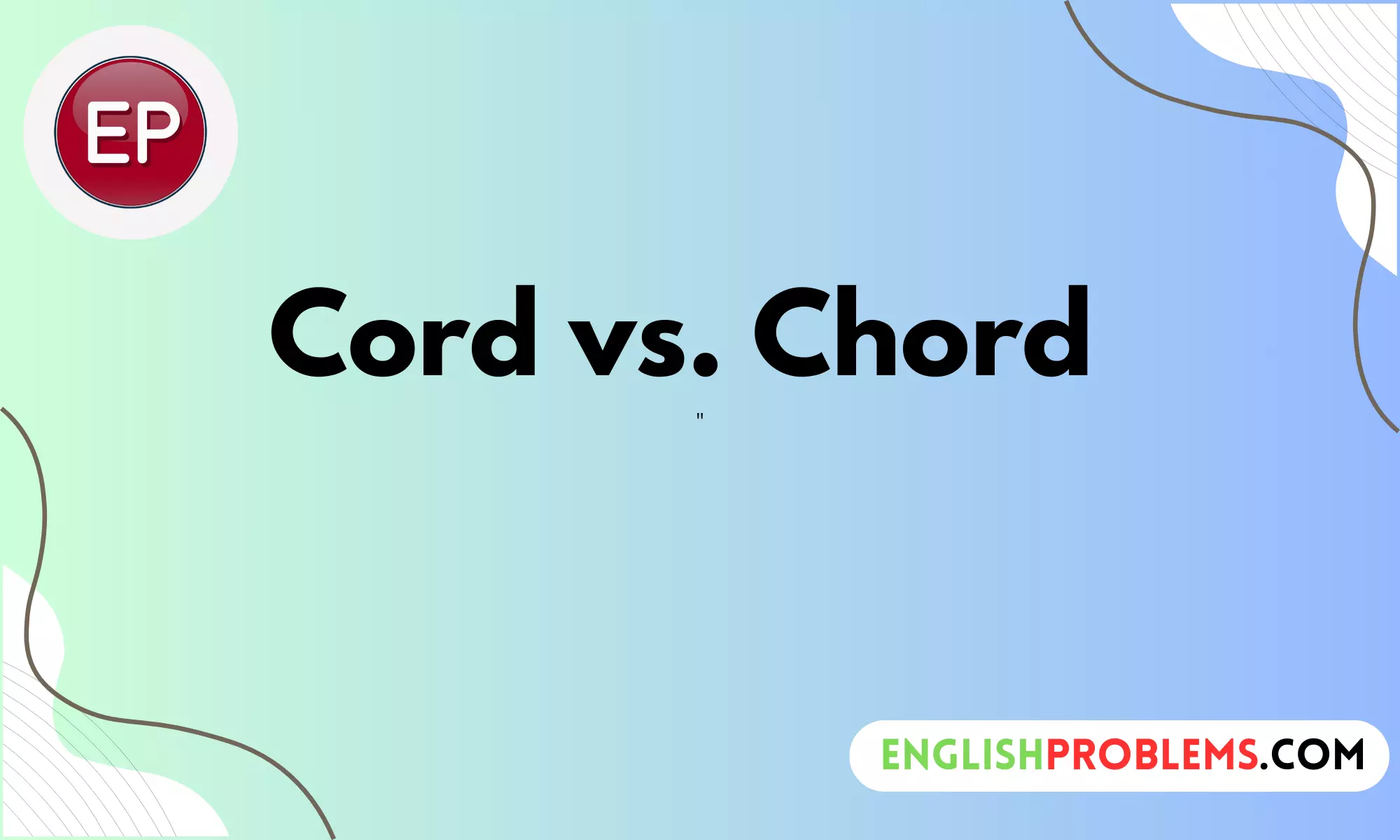When you come across the terms “cord” and “chord,” you might wonder if they are interchangeable or if there’s a distinct difference between them. Many people use these terms incorrectly, but understanding their meanings can enhance both your communication and comprehension in various contexts.
This article delves into the specifics of each term, clarifying their differences, common mistakes, and providing practical guidance to use them correctly.
Understanding “Cord”
Definition
The term “cord” refers to a flexible, strong string or rope made of fibers, wires, or strands twisted together. In everyday language, it often pertains to items like electrical cords or tie cords.
- Electrical Cord: A type of wire used to connect electrical devices to power sources.
- Rope Cord: A strong, often woven string used for tying or securing objects.
Usage Examples
To better grasp the concept of “cord,” consider these examples:
- Electrical Cord: “The lamp’s electrical cord was tangled behind the sofa.”
- Rope Cord: “We used a cord to tie the bundle of newspapers together.”
Common Confusions
The term “cord” might be mistaken for “chord” due to their similar pronunciation and spelling. People might confuse the two when discussing topics related to music or cables, not realizing that they refer to completely different concepts.
Understanding “Chord”
Definition
On the other hand, “chord” primarily has two meanings:
- Musical Chord: A combination of notes played simultaneously to create harmony. For example, a C major chord consists of the notes C, E, and G.
- Geometric Chord: A line segment whose endpoints lie on a curve, typically in a circle. It is crucial in geometry and trigonometry.
Usage Examples
To illustrate the use of “chord,” here are some context-specific sentences:
- Musical Chord: “She played a beautiful D minor chord on the piano.”
- Geometric Chord: “In geometry class, we learned how to calculate the length of a chord in a circle.”
Common Confusions
People might confuse “chord” with “cord” when talking about music or geometry due to the similar pronunciation. Misunderstandings can occur if one is not familiar with the specific contexts in which these terms are used.
Key Differences Between “Cord” and “Chord”
Contextual Differences
Understanding when to use “cord” versus “chord” relies heavily on context:
- Cord is used for physical objects like wires, ropes, or strings.
- Chord is used in music and geometry to describe specific concepts.
Table: Contextual Differences
TermContextExampleCordPhysical ObjectElectrical cord, rope cordChordMusic/GeometryMusical chord, geometric chord
Visual and Functional Distinctions
Cord is a tangible object you can touch and see. It has a practical use, like connecting devices or securing items.
Chord, in contrast, refers to concepts rather than physical objects. You cannot physically touch a musical or geometric chord but can understand its function through its role in music and geometry.
Mnemonic Tips
To remember the difference between “cord” and “chord,” consider these tips:
- Cord: Think of “cord” as something you can physically hold or use.
- Chord: Recall “chord” in terms of harmony or geometry, not a tangible item.
Practical Applications and Examples
Everyday Usage
Understanding the distinction between “cord” and “chord” is essential in various situations:
- Cord: In home maintenance or electronics, it’s vital to use the correct term when referring to cables or ropes.
- Chord: In music or math classes, knowing the difference helps in clear communication and comprehension.
Case Study: Music vs. Electrical Work
In a music class, students discussing “chords” will be referring to harmonies and musical theory. Conversely, in an electrical workshop, talking about “cords” involves discussing wires and cables used for connecting equipment.
Professional and Academic Contexts
In specific fields, precise terminology is crucial:
- Music Theory: Understanding and using “chord” accurately is essential for discussing musical compositions and analysis.
- Mathematics: In geometry, “chord” is a fundamental concept in understanding the properties of circles and curves.
Table: Professional and Academic Uses
FieldTermUsageMusicChordDescribing combinations of notesMathematicsChordAnalyzing properties of curvesElectronicsCordReferring to cables and wires
Common Mistakes and Misuses
Frequent Errors
Here are some common mistakes people make with “cord” and “chord”:
- Misusing Chord for Cord: Referring to an “electrical chord” instead of “electrical cord.”
- Misusing Cord for Chord: Talking about “musical cord” when you mean “musical chord.”
Correcting Mistakes
To avoid these errors:
- Review Context: Always consider whether you’re discussing a physical object or a concept in music or geometry.
- Practice Usage: Regularly practicing the correct usage of “cord” and “chord” can help solidify your understanding.
Additional Resources
Further Reading
For more detailed information on “cord” and “chord,” consider these resources:
- Books:
- The Elements of Style by William Strunk Jr. and E.B. White
- Music Theory for Dummies by Michael Pilhofer and Holly Day
Practice Exercises
Test your understanding with these exercises:
- Identify the Term: Provide sentences where you choose between “cord” and “chord.”
- Correct the Mistake: Find and correct errors in sample sentences involving “cord” and “chord.”
Conclusion
Summary
In summary, understanding the difference between “cord” and “chord” is crucial for clear and accurate communication. “Cord” refers to physical objects like wires and ropes, while “chord” relates to musical and geometric concepts.
Final Thoughts
Using these terms correctly not only enhances your communication but also reflects your attention to detail and understanding of different contexts.
Call to Action
Apply this knowledge in your daily and professional life to avoid confusion and communicate more effectively. Share this article to help others understand the difference between “cord” and “chord”!
By following this comprehensive guide, you’ll ensure you’re using these terms correctly and confidently.

Lucy Wright combines her academic background with a flair for simplifying the intricate details of grammar. Her practical advice and clear explanations empower readers to improve their writing skills and grasp challenging concepts effortlessly.










